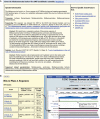The UCSC Archaeal Genome Browser: 2012 update
- PMID: 22080555
- PMCID: PMC3245099
- DOI: 10.1093/nar/gkr990
The UCSC Archaeal Genome Browser: 2012 update
Abstract
The UCSC Archaeal Genome Browser (http://archaea.ucsc.edu) offers a graphical web-based resource for exploration and discovery within archaeal and other selected microbial genomes. By bringing together existing gene annotations, gene expression data, multiple-genome alignments, pre-computed sequence comparisons and other specialized analysis tracks, the genome browser is a powerful aggregator of varied genomic information. The genome browser environment maintains the current look-and-feel of the vertebrate UCSC Genome Browser, but also integrates archaeal and bacterial-specific tracks with a few graphic display enhancements. The browser currently contains 115 archaeal genomes, plus 31 genomes of viruses known to infect archaea. Some of the recently developed or enhanced tracks visualize data from published high-throughput RNA-sequencing studies, the NCBI Conserved Domain Database, sequences from pre-genome sequencing studies, predicted gene boundaries from three different protein gene prediction algorithms, tRNAscan-SE gene predictions with RNA secondary structures and CRISPR locus predictions. We have also developed a companion resource, the Archaeal COG Browser, to provide better search and display of arCOG gene function classifications, including their phylogenetic distribution among available archaeal genomes.
Figures



References
Publication types
MeSH terms
Substances
LinkOut - more resources
Full Text Sources
Other Literature Sources

